SNPG903 Spring 2018: Development of Nursing Care - Fatigue Report
VerifiedAdded on 2023/06/04
|16
|4407
|115
Report
AI Summary
This report analyzes compassion fatigue among nursing practitioners, examining changes in nursing practice and the influence of workplace culture. It explores the emotional and psychological stressors contributing to compassion fatigue, emphasizing the critical role of the work environment in either fostering compassion satisfaction or exacerbating fatigue. Observations from care receivers highlight the prevalence of compassion fatigue, influenced by factors such as workload, patient acuity, and emotional demands. The report analyzes effective cultural frameworks, emphasizing the importance of personal support, flexible work arrangements, and a positive organizational culture in promoting compassion satisfaction. Recommendations include open communication, work-life balance initiatives, and supportive work environments to mitigate compassion fatigue and improve overall well-being among nursing professionals. Desklib provides access to similar past papers and solved assignments for students.
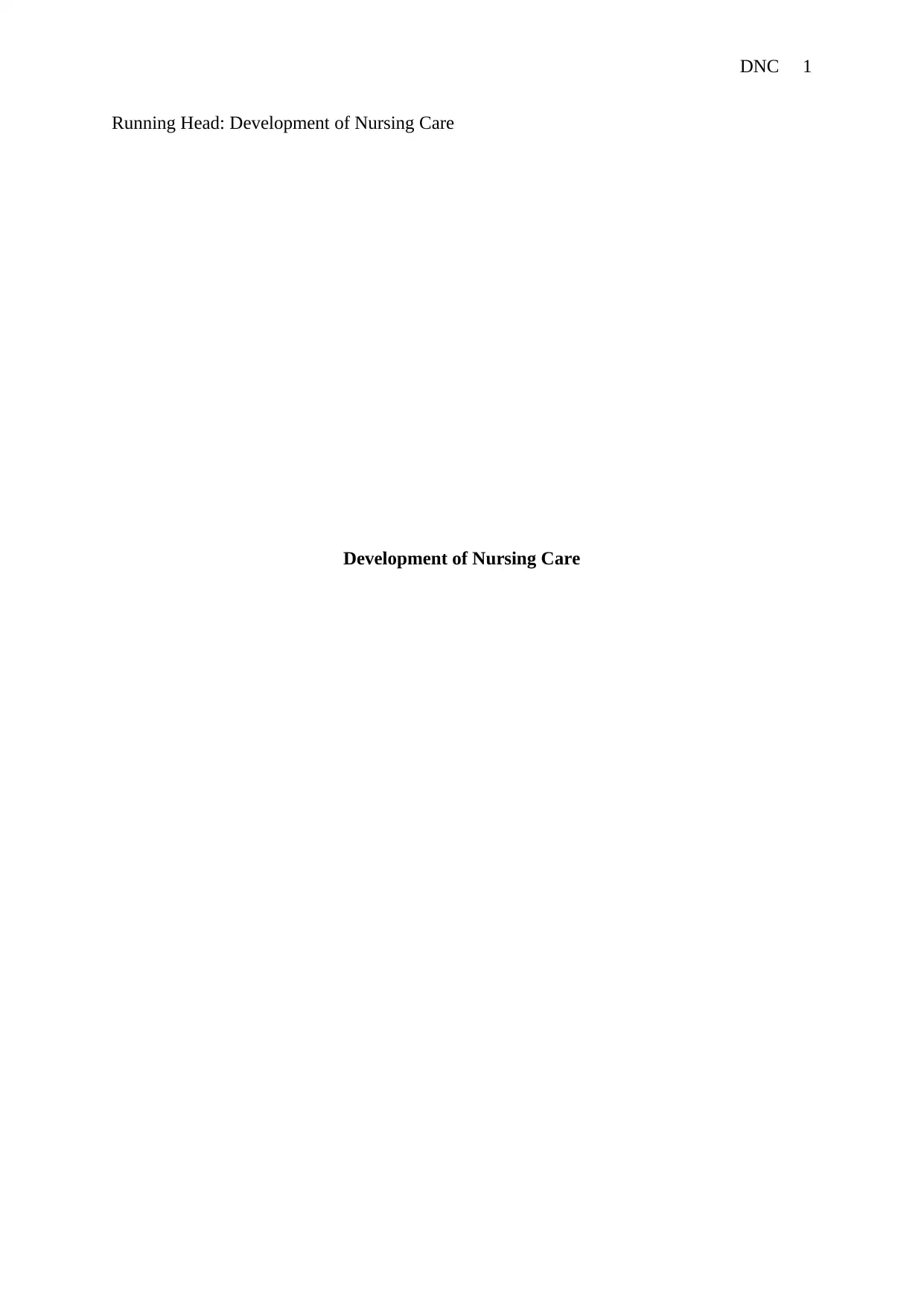
DNC 1
Running Head: Development of Nursing Care
Development of Nursing Care
Running Head: Development of Nursing Care
Development of Nursing Care
Paraphrase This Document
Need a fresh take? Get an instant paraphrase of this document with our AI Paraphraser
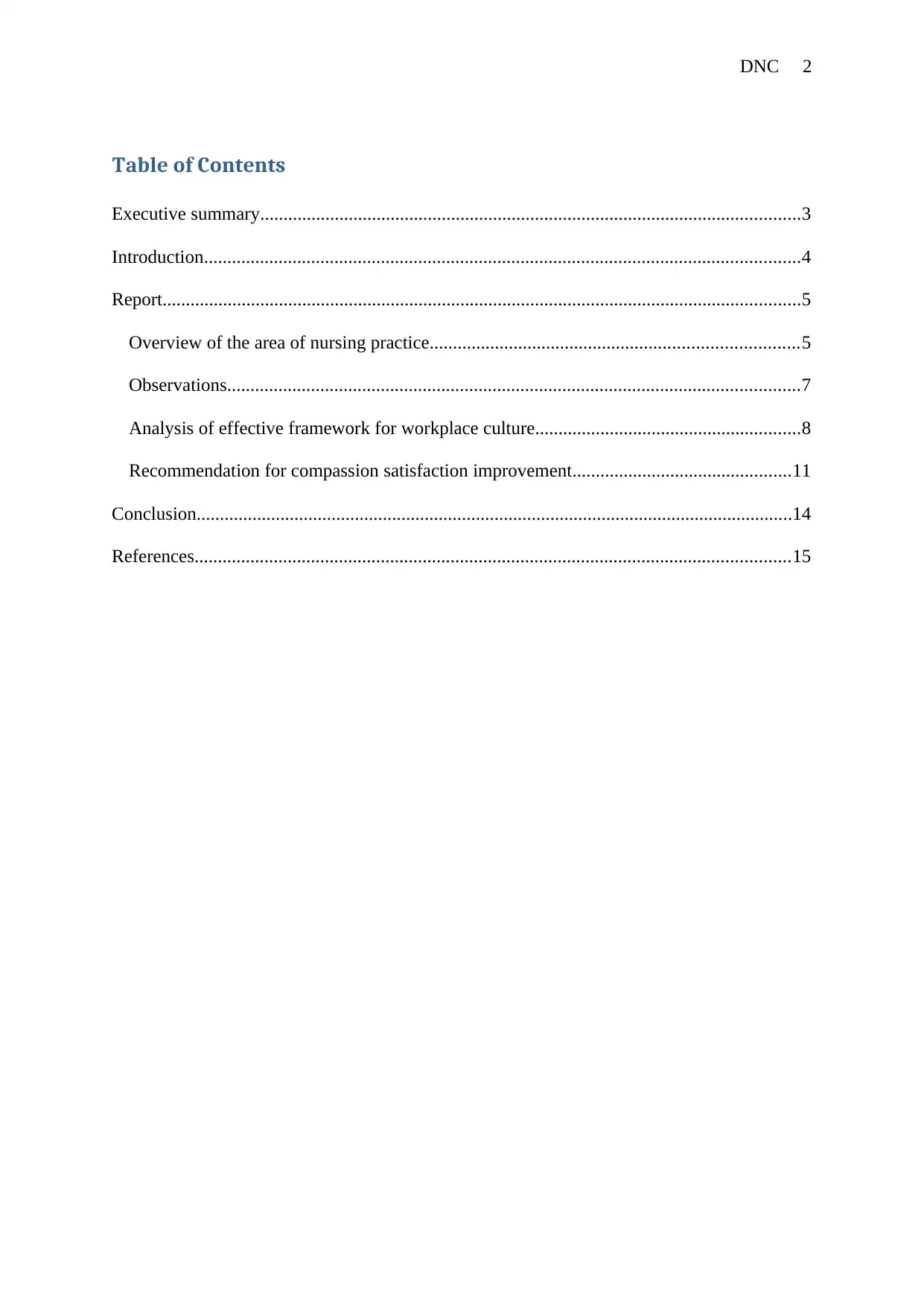
DNC 2
Table of Contents
Executive summary....................................................................................................................3
Introduction................................................................................................................................4
Report.........................................................................................................................................5
Overview of the area of nursing practice...............................................................................5
Observations...........................................................................................................................7
Analysis of effective framework for workplace culture.........................................................8
Recommendation for compassion satisfaction improvement...............................................11
Conclusion................................................................................................................................14
References................................................................................................................................15
Table of Contents
Executive summary....................................................................................................................3
Introduction................................................................................................................................4
Report.........................................................................................................................................5
Overview of the area of nursing practice...............................................................................5
Observations...........................................................................................................................7
Analysis of effective framework for workplace culture.........................................................8
Recommendation for compassion satisfaction improvement...............................................11
Conclusion................................................................................................................................14
References................................................................................................................................15
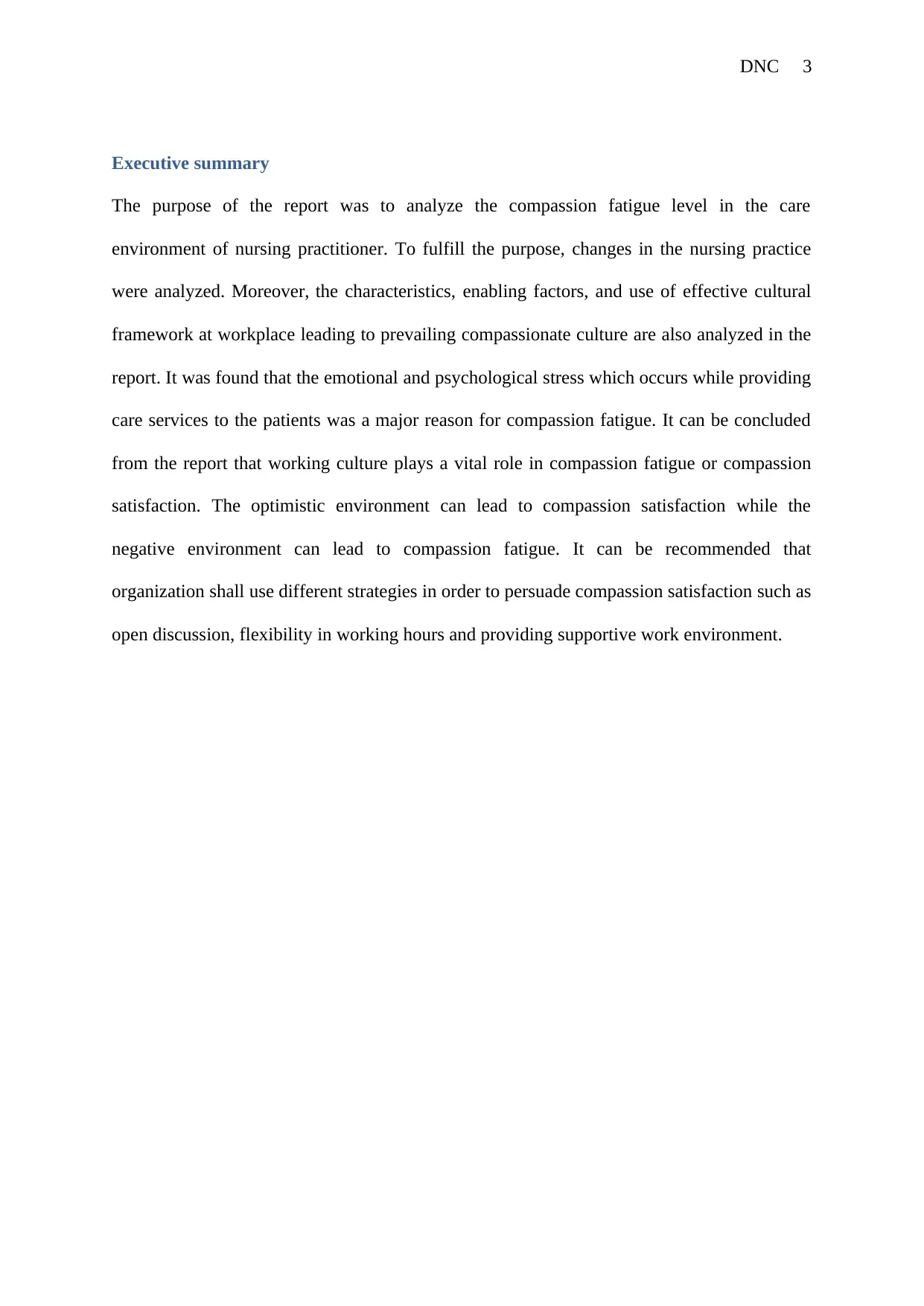
DNC 3
Executive summary
The purpose of the report was to analyze the compassion fatigue level in the care
environment of nursing practitioner. To fulfill the purpose, changes in the nursing practice
were analyzed. Moreover, the characteristics, enabling factors, and use of effective cultural
framework at workplace leading to prevailing compassionate culture are also analyzed in the
report. It was found that the emotional and psychological stress which occurs while providing
care services to the patients was a major reason for compassion fatigue. It can be concluded
from the report that working culture plays a vital role in compassion fatigue or compassion
satisfaction. The optimistic environment can lead to compassion satisfaction while the
negative environment can lead to compassion fatigue. It can be recommended that
organization shall use different strategies in order to persuade compassion satisfaction such as
open discussion, flexibility in working hours and providing supportive work environment.
Executive summary
The purpose of the report was to analyze the compassion fatigue level in the care
environment of nursing practitioner. To fulfill the purpose, changes in the nursing practice
were analyzed. Moreover, the characteristics, enabling factors, and use of effective cultural
framework at workplace leading to prevailing compassionate culture are also analyzed in the
report. It was found that the emotional and psychological stress which occurs while providing
care services to the patients was a major reason for compassion fatigue. It can be concluded
from the report that working culture plays a vital role in compassion fatigue or compassion
satisfaction. The optimistic environment can lead to compassion satisfaction while the
negative environment can lead to compassion fatigue. It can be recommended that
organization shall use different strategies in order to persuade compassion satisfaction such as
open discussion, flexibility in working hours and providing supportive work environment.
⊘ This is a preview!⊘
Do you want full access?
Subscribe today to unlock all pages.

Trusted by 1+ million students worldwide
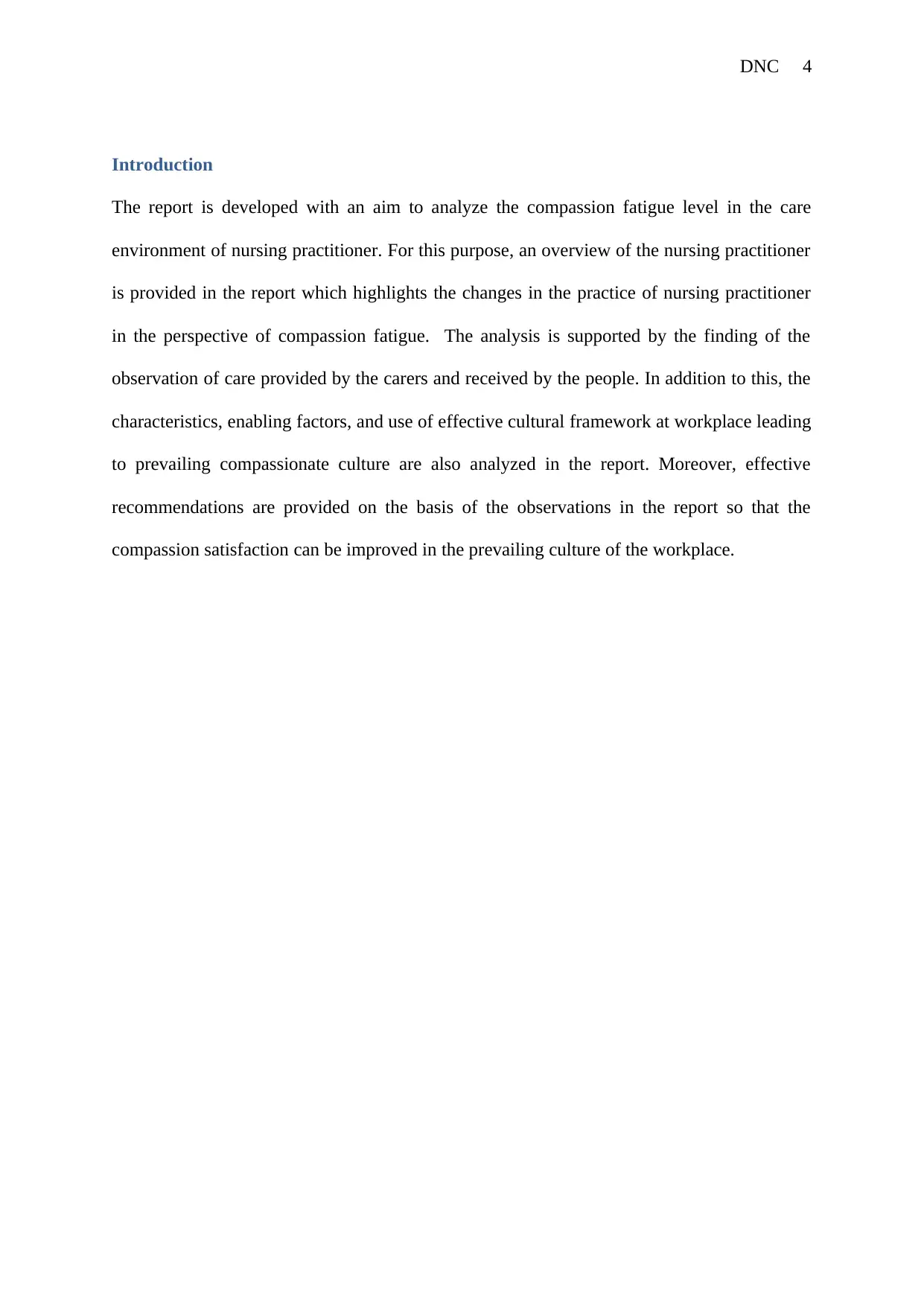
DNC 4
Introduction
The report is developed with an aim to analyze the compassion fatigue level in the care
environment of nursing practitioner. For this purpose, an overview of the nursing practitioner
is provided in the report which highlights the changes in the practice of nursing practitioner
in the perspective of compassion fatigue. The analysis is supported by the finding of the
observation of care provided by the carers and received by the people. In addition to this, the
characteristics, enabling factors, and use of effective cultural framework at workplace leading
to prevailing compassionate culture are also analyzed in the report. Moreover, effective
recommendations are provided on the basis of the observations in the report so that the
compassion satisfaction can be improved in the prevailing culture of the workplace.
Introduction
The report is developed with an aim to analyze the compassion fatigue level in the care
environment of nursing practitioner. For this purpose, an overview of the nursing practitioner
is provided in the report which highlights the changes in the practice of nursing practitioner
in the perspective of compassion fatigue. The analysis is supported by the finding of the
observation of care provided by the carers and received by the people. In addition to this, the
characteristics, enabling factors, and use of effective cultural framework at workplace leading
to prevailing compassionate culture are also analyzed in the report. Moreover, effective
recommendations are provided on the basis of the observations in the report so that the
compassion satisfaction can be improved in the prevailing culture of the workplace.
Paraphrase This Document
Need a fresh take? Get an instant paraphrase of this document with our AI Paraphraser
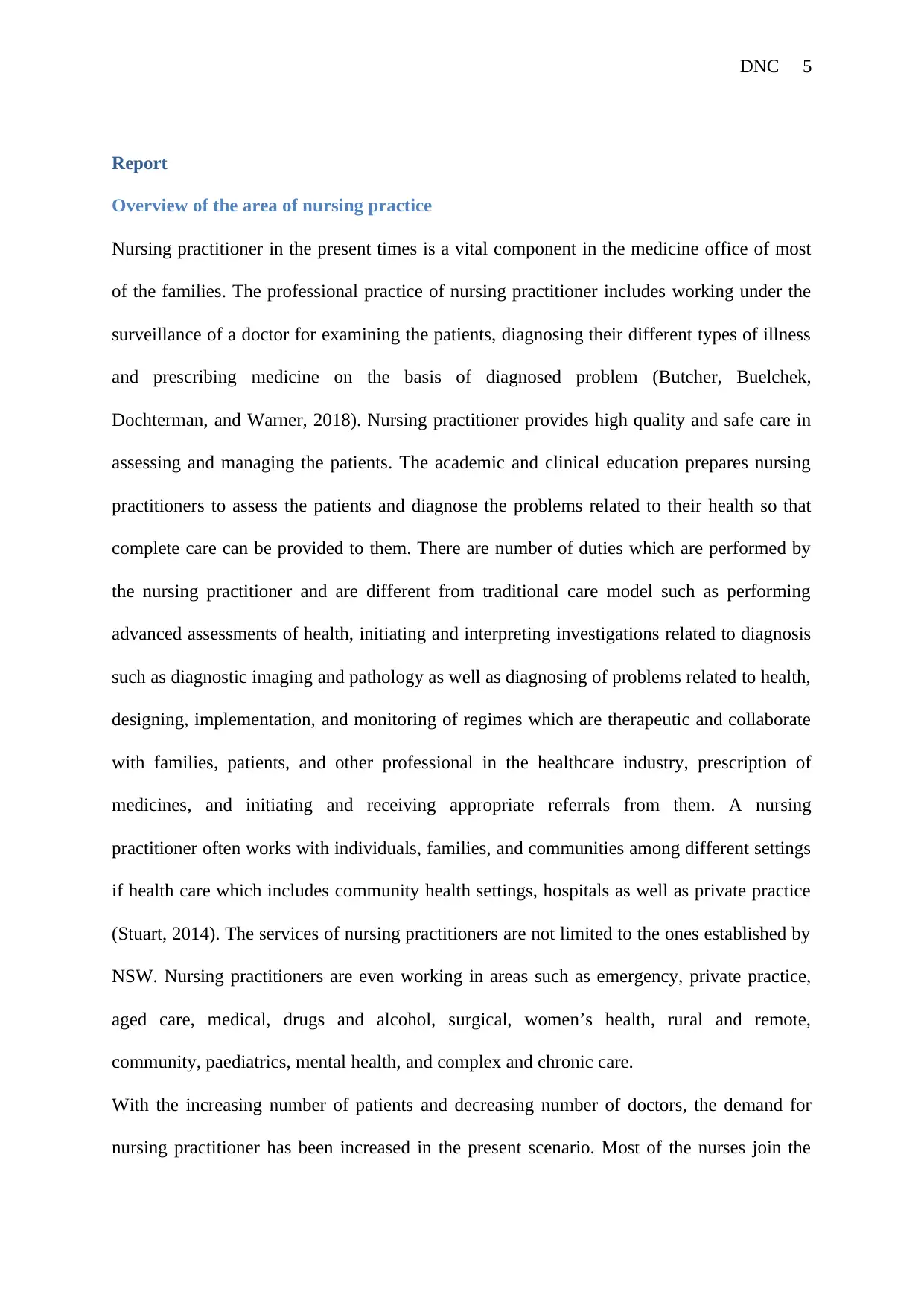
DNC 5
Report
Overview of the area of nursing practice
Nursing practitioner in the present times is a vital component in the medicine office of most
of the families. The professional practice of nursing practitioner includes working under the
surveillance of a doctor for examining the patients, diagnosing their different types of illness
and prescribing medicine on the basis of diagnosed problem (Butcher, Buelchek,
Dochterman, and Warner, 2018). Nursing practitioner provides high quality and safe care in
assessing and managing the patients. The academic and clinical education prepares nursing
practitioners to assess the patients and diagnose the problems related to their health so that
complete care can be provided to them. There are number of duties which are performed by
the nursing practitioner and are different from traditional care model such as performing
advanced assessments of health, initiating and interpreting investigations related to diagnosis
such as diagnostic imaging and pathology as well as diagnosing of problems related to health,
designing, implementation, and monitoring of regimes which are therapeutic and collaborate
with families, patients, and other professional in the healthcare industry, prescription of
medicines, and initiating and receiving appropriate referrals from them. A nursing
practitioner often works with individuals, families, and communities among different settings
if health care which includes community health settings, hospitals as well as private practice
(Stuart, 2014). The services of nursing practitioners are not limited to the ones established by
NSW. Nursing practitioners are even working in areas such as emergency, private practice,
aged care, medical, drugs and alcohol, surgical, women’s health, rural and remote,
community, paediatrics, mental health, and complex and chronic care.
With the increasing number of patients and decreasing number of doctors, the demand for
nursing practitioner has been increased in the present scenario. Most of the nurses join the
Report
Overview of the area of nursing practice
Nursing practitioner in the present times is a vital component in the medicine office of most
of the families. The professional practice of nursing practitioner includes working under the
surveillance of a doctor for examining the patients, diagnosing their different types of illness
and prescribing medicine on the basis of diagnosed problem (Butcher, Buelchek,
Dochterman, and Warner, 2018). Nursing practitioner provides high quality and safe care in
assessing and managing the patients. The academic and clinical education prepares nursing
practitioners to assess the patients and diagnose the problems related to their health so that
complete care can be provided to them. There are number of duties which are performed by
the nursing practitioner and are different from traditional care model such as performing
advanced assessments of health, initiating and interpreting investigations related to diagnosis
such as diagnostic imaging and pathology as well as diagnosing of problems related to health,
designing, implementation, and monitoring of regimes which are therapeutic and collaborate
with families, patients, and other professional in the healthcare industry, prescription of
medicines, and initiating and receiving appropriate referrals from them. A nursing
practitioner often works with individuals, families, and communities among different settings
if health care which includes community health settings, hospitals as well as private practice
(Stuart, 2014). The services of nursing practitioners are not limited to the ones established by
NSW. Nursing practitioners are even working in areas such as emergency, private practice,
aged care, medical, drugs and alcohol, surgical, women’s health, rural and remote,
community, paediatrics, mental health, and complex and chronic care.
With the increasing number of patients and decreasing number of doctors, the demand for
nursing practitioner has been increased in the present scenario. Most of the nurses join the
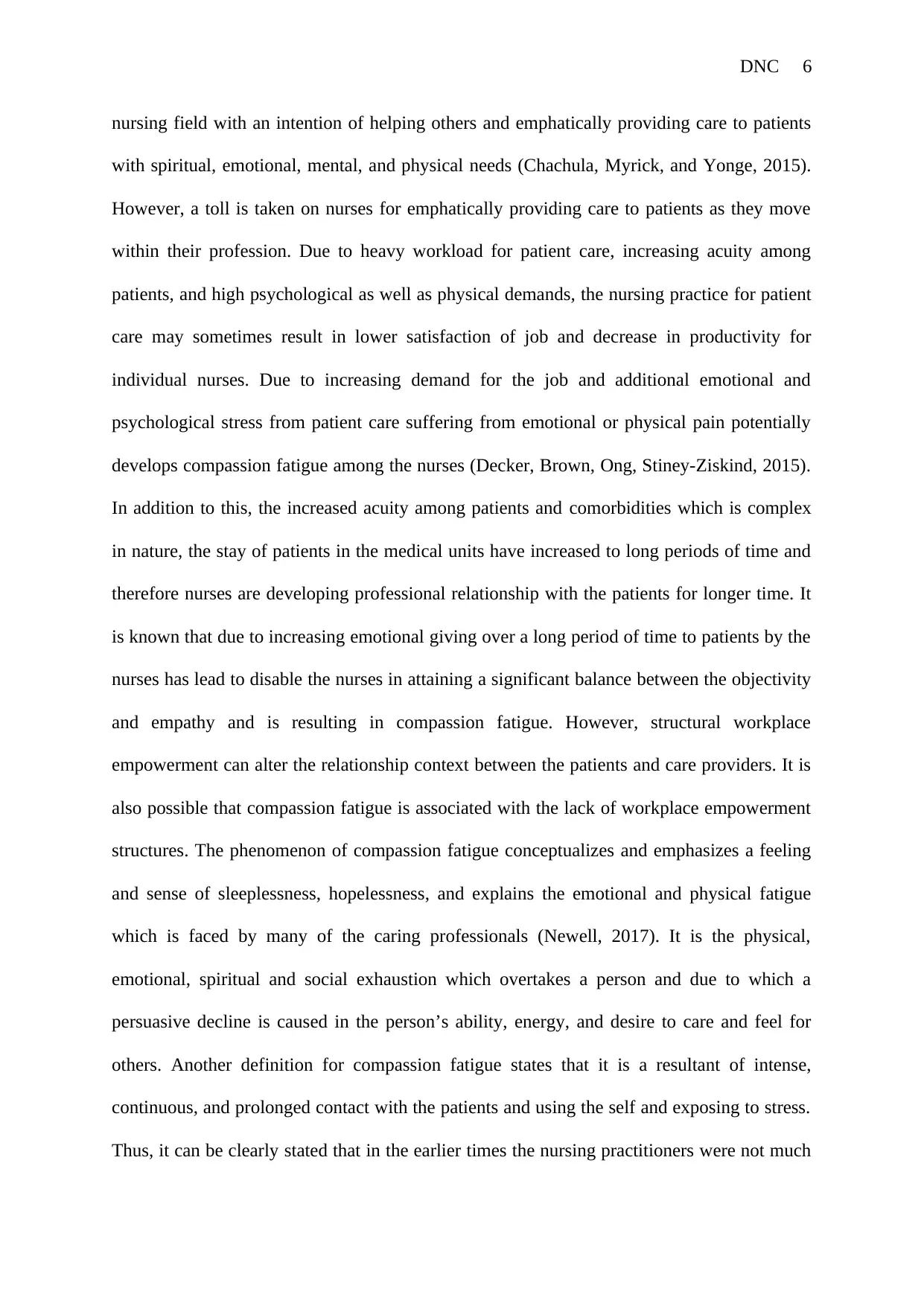
DNC 6
nursing field with an intention of helping others and emphatically providing care to patients
with spiritual, emotional, mental, and physical needs (Chachula, Myrick, and Yonge, 2015).
However, a toll is taken on nurses for emphatically providing care to patients as they move
within their profession. Due to heavy workload for patient care, increasing acuity among
patients, and high psychological as well as physical demands, the nursing practice for patient
care may sometimes result in lower satisfaction of job and decrease in productivity for
individual nurses. Due to increasing demand for the job and additional emotional and
psychological stress from patient care suffering from emotional or physical pain potentially
develops compassion fatigue among the nurses (Decker, Brown, Ong, Stiney-Ziskind, 2015).
In addition to this, the increased acuity among patients and comorbidities which is complex
in nature, the stay of patients in the medical units have increased to long periods of time and
therefore nurses are developing professional relationship with the patients for longer time. It
is known that due to increasing emotional giving over a long period of time to patients by the
nurses has lead to disable the nurses in attaining a significant balance between the objectivity
and empathy and is resulting in compassion fatigue. However, structural workplace
empowerment can alter the relationship context between the patients and care providers. It is
also possible that compassion fatigue is associated with the lack of workplace empowerment
structures. The phenomenon of compassion fatigue conceptualizes and emphasizes a feeling
and sense of sleeplessness, hopelessness, and explains the emotional and physical fatigue
which is faced by many of the caring professionals (Newell, 2017). It is the physical,
emotional, spiritual and social exhaustion which overtakes a person and due to which a
persuasive decline is caused in the person’s ability, energy, and desire to care and feel for
others. Another definition for compassion fatigue states that it is a resultant of intense,
continuous, and prolonged contact with the patients and using the self and exposing to stress.
Thus, it can be clearly stated that in the earlier times the nursing practitioners were not much
nursing field with an intention of helping others and emphatically providing care to patients
with spiritual, emotional, mental, and physical needs (Chachula, Myrick, and Yonge, 2015).
However, a toll is taken on nurses for emphatically providing care to patients as they move
within their profession. Due to heavy workload for patient care, increasing acuity among
patients, and high psychological as well as physical demands, the nursing practice for patient
care may sometimes result in lower satisfaction of job and decrease in productivity for
individual nurses. Due to increasing demand for the job and additional emotional and
psychological stress from patient care suffering from emotional or physical pain potentially
develops compassion fatigue among the nurses (Decker, Brown, Ong, Stiney-Ziskind, 2015).
In addition to this, the increased acuity among patients and comorbidities which is complex
in nature, the stay of patients in the medical units have increased to long periods of time and
therefore nurses are developing professional relationship with the patients for longer time. It
is known that due to increasing emotional giving over a long period of time to patients by the
nurses has lead to disable the nurses in attaining a significant balance between the objectivity
and empathy and is resulting in compassion fatigue. However, structural workplace
empowerment can alter the relationship context between the patients and care providers. It is
also possible that compassion fatigue is associated with the lack of workplace empowerment
structures. The phenomenon of compassion fatigue conceptualizes and emphasizes a feeling
and sense of sleeplessness, hopelessness, and explains the emotional and physical fatigue
which is faced by many of the caring professionals (Newell, 2017). It is the physical,
emotional, spiritual and social exhaustion which overtakes a person and due to which a
persuasive decline is caused in the person’s ability, energy, and desire to care and feel for
others. Another definition for compassion fatigue states that it is a resultant of intense,
continuous, and prolonged contact with the patients and using the self and exposing to stress.
Thus, it can be clearly stated that in the earlier times the nursing practitioners were not much
⊘ This is a preview!⊘
Do you want full access?
Subscribe today to unlock all pages.

Trusted by 1+ million students worldwide
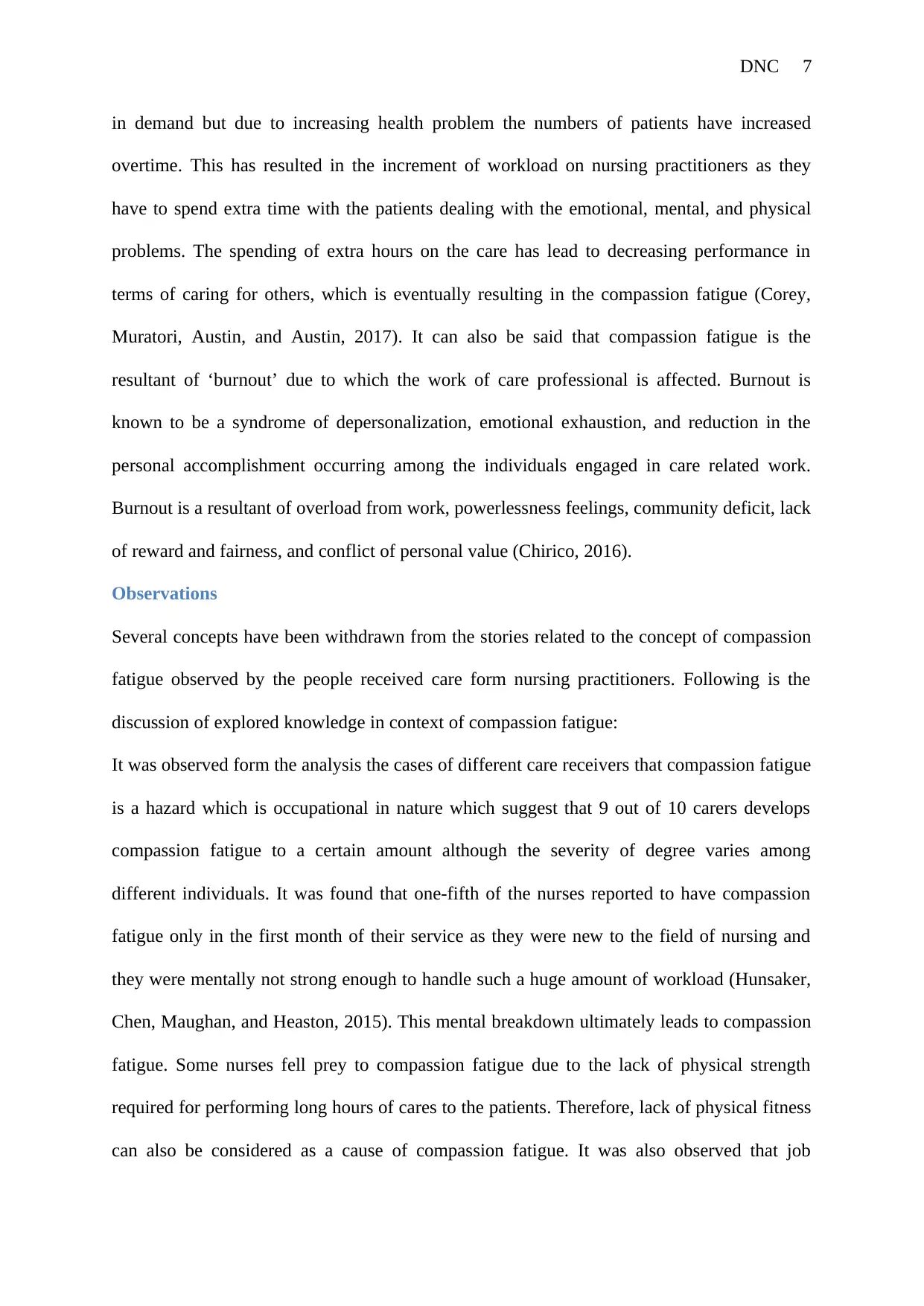
DNC 7
in demand but due to increasing health problem the numbers of patients have increased
overtime. This has resulted in the increment of workload on nursing practitioners as they
have to spend extra time with the patients dealing with the emotional, mental, and physical
problems. The spending of extra hours on the care has lead to decreasing performance in
terms of caring for others, which is eventually resulting in the compassion fatigue (Corey,
Muratori, Austin, and Austin, 2017). It can also be said that compassion fatigue is the
resultant of ‘burnout’ due to which the work of care professional is affected. Burnout is
known to be a syndrome of depersonalization, emotional exhaustion, and reduction in the
personal accomplishment occurring among the individuals engaged in care related work.
Burnout is a resultant of overload from work, powerlessness feelings, community deficit, lack
of reward and fairness, and conflict of personal value (Chirico, 2016).
Observations
Several concepts have been withdrawn from the stories related to the concept of compassion
fatigue observed by the people received care form nursing practitioners. Following is the
discussion of explored knowledge in context of compassion fatigue:
It was observed form the analysis the cases of different care receivers that compassion fatigue
is a hazard which is occupational in nature which suggest that 9 out of 10 carers develops
compassion fatigue to a certain amount although the severity of degree varies among
different individuals. It was found that one-fifth of the nurses reported to have compassion
fatigue only in the first month of their service as they were new to the field of nursing and
they were mentally not strong enough to handle such a huge amount of workload (Hunsaker,
Chen, Maughan, and Heaston, 2015). This mental breakdown ultimately leads to compassion
fatigue. Some nurses fell prey to compassion fatigue due to the lack of physical strength
required for performing long hours of cares to the patients. Therefore, lack of physical fitness
can also be considered as a cause of compassion fatigue. It was also observed that job
in demand but due to increasing health problem the numbers of patients have increased
overtime. This has resulted in the increment of workload on nursing practitioners as they
have to spend extra time with the patients dealing with the emotional, mental, and physical
problems. The spending of extra hours on the care has lead to decreasing performance in
terms of caring for others, which is eventually resulting in the compassion fatigue (Corey,
Muratori, Austin, and Austin, 2017). It can also be said that compassion fatigue is the
resultant of ‘burnout’ due to which the work of care professional is affected. Burnout is
known to be a syndrome of depersonalization, emotional exhaustion, and reduction in the
personal accomplishment occurring among the individuals engaged in care related work.
Burnout is a resultant of overload from work, powerlessness feelings, community deficit, lack
of reward and fairness, and conflict of personal value (Chirico, 2016).
Observations
Several concepts have been withdrawn from the stories related to the concept of compassion
fatigue observed by the people received care form nursing practitioners. Following is the
discussion of explored knowledge in context of compassion fatigue:
It was observed form the analysis the cases of different care receivers that compassion fatigue
is a hazard which is occupational in nature which suggest that 9 out of 10 carers develops
compassion fatigue to a certain amount although the severity of degree varies among
different individuals. It was found that one-fifth of the nurses reported to have compassion
fatigue only in the first month of their service as they were new to the field of nursing and
they were mentally not strong enough to handle such a huge amount of workload (Hunsaker,
Chen, Maughan, and Heaston, 2015). This mental breakdown ultimately leads to compassion
fatigue. Some nurses fell prey to compassion fatigue due to the lack of physical strength
required for performing long hours of cares to the patients. Therefore, lack of physical fitness
can also be considered as a cause of compassion fatigue. It was also observed that job
Paraphrase This Document
Need a fresh take? Get an instant paraphrase of this document with our AI Paraphraser
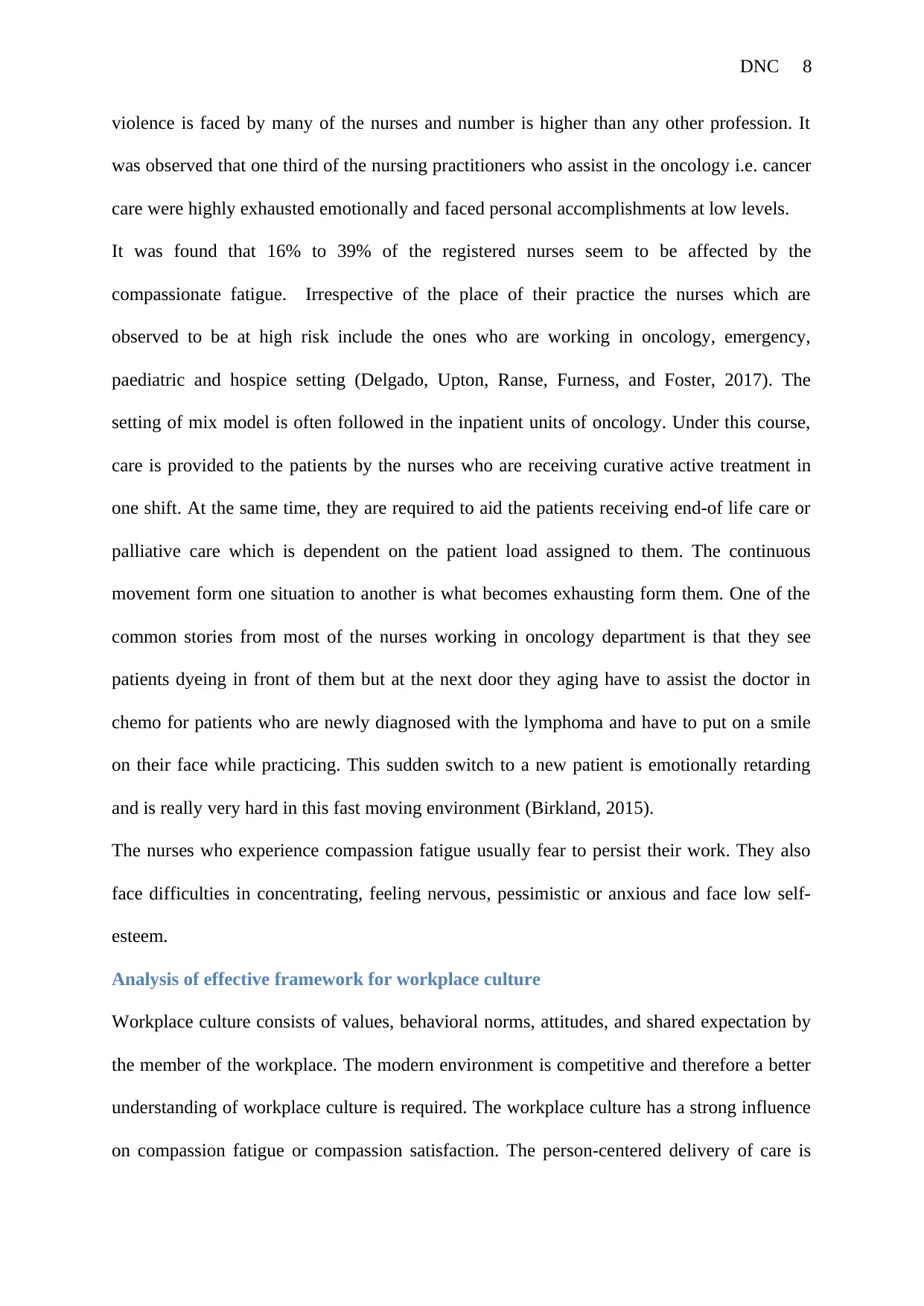
DNC 8
violence is faced by many of the nurses and number is higher than any other profession. It
was observed that one third of the nursing practitioners who assist in the oncology i.e. cancer
care were highly exhausted emotionally and faced personal accomplishments at low levels.
It was found that 16% to 39% of the registered nurses seem to be affected by the
compassionate fatigue. Irrespective of the place of their practice the nurses which are
observed to be at high risk include the ones who are working in oncology, emergency,
paediatric and hospice setting (Delgado, Upton, Ranse, Furness, and Foster, 2017). The
setting of mix model is often followed in the inpatient units of oncology. Under this course,
care is provided to the patients by the nurses who are receiving curative active treatment in
one shift. At the same time, they are required to aid the patients receiving end-of life care or
palliative care which is dependent on the patient load assigned to them. The continuous
movement form one situation to another is what becomes exhausting form them. One of the
common stories from most of the nurses working in oncology department is that they see
patients dyeing in front of them but at the next door they aging have to assist the doctor in
chemo for patients who are newly diagnosed with the lymphoma and have to put on a smile
on their face while practicing. This sudden switch to a new patient is emotionally retarding
and is really very hard in this fast moving environment (Birkland, 2015).
The nurses who experience compassion fatigue usually fear to persist their work. They also
face difficulties in concentrating, feeling nervous, pessimistic or anxious and face low self-
esteem.
Analysis of effective framework for workplace culture
Workplace culture consists of values, behavioral norms, attitudes, and shared expectation by
the member of the workplace. The modern environment is competitive and therefore a better
understanding of workplace culture is required. The workplace culture has a strong influence
on compassion fatigue or compassion satisfaction. The person-centered delivery of care is
violence is faced by many of the nurses and number is higher than any other profession. It
was observed that one third of the nursing practitioners who assist in the oncology i.e. cancer
care were highly exhausted emotionally and faced personal accomplishments at low levels.
It was found that 16% to 39% of the registered nurses seem to be affected by the
compassionate fatigue. Irrespective of the place of their practice the nurses which are
observed to be at high risk include the ones who are working in oncology, emergency,
paediatric and hospice setting (Delgado, Upton, Ranse, Furness, and Foster, 2017). The
setting of mix model is often followed in the inpatient units of oncology. Under this course,
care is provided to the patients by the nurses who are receiving curative active treatment in
one shift. At the same time, they are required to aid the patients receiving end-of life care or
palliative care which is dependent on the patient load assigned to them. The continuous
movement form one situation to another is what becomes exhausting form them. One of the
common stories from most of the nurses working in oncology department is that they see
patients dyeing in front of them but at the next door they aging have to assist the doctor in
chemo for patients who are newly diagnosed with the lymphoma and have to put on a smile
on their face while practicing. This sudden switch to a new patient is emotionally retarding
and is really very hard in this fast moving environment (Birkland, 2015).
The nurses who experience compassion fatigue usually fear to persist their work. They also
face difficulties in concentrating, feeling nervous, pessimistic or anxious and face low self-
esteem.
Analysis of effective framework for workplace culture
Workplace culture consists of values, behavioral norms, attitudes, and shared expectation by
the member of the workplace. The modern environment is competitive and therefore a better
understanding of workplace culture is required. The workplace culture has a strong influence
on compassion fatigue or compassion satisfaction. The person-centered delivery of care is
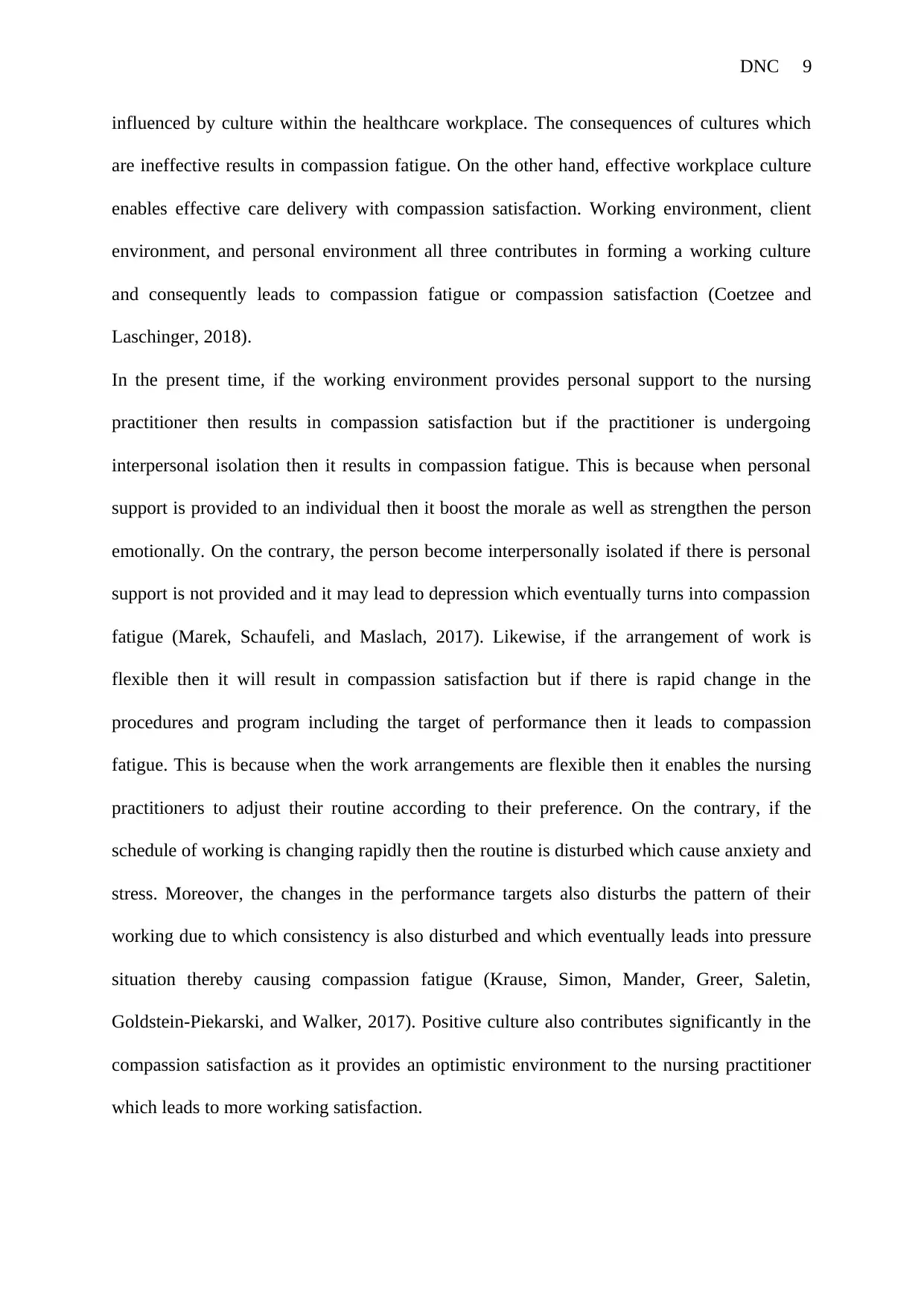
DNC 9
influenced by culture within the healthcare workplace. The consequences of cultures which
are ineffective results in compassion fatigue. On the other hand, effective workplace culture
enables effective care delivery with compassion satisfaction. Working environment, client
environment, and personal environment all three contributes in forming a working culture
and consequently leads to compassion fatigue or compassion satisfaction (Coetzee and
Laschinger, 2018).
In the present time, if the working environment provides personal support to the nursing
practitioner then results in compassion satisfaction but if the practitioner is undergoing
interpersonal isolation then it results in compassion fatigue. This is because when personal
support is provided to an individual then it boost the morale as well as strengthen the person
emotionally. On the contrary, the person become interpersonally isolated if there is personal
support is not provided and it may lead to depression which eventually turns into compassion
fatigue (Marek, Schaufeli, and Maslach, 2017). Likewise, if the arrangement of work is
flexible then it will result in compassion satisfaction but if there is rapid change in the
procedures and program including the target of performance then it leads to compassion
fatigue. This is because when the work arrangements are flexible then it enables the nursing
practitioners to adjust their routine according to their preference. On the contrary, if the
schedule of working is changing rapidly then the routine is disturbed which cause anxiety and
stress. Moreover, the changes in the performance targets also disturbs the pattern of their
working due to which consistency is also disturbed and which eventually leads into pressure
situation thereby causing compassion fatigue (Krause, Simon, Mander, Greer, Saletin,
Goldstein-Piekarski, and Walker, 2017). Positive culture also contributes significantly in the
compassion satisfaction as it provides an optimistic environment to the nursing practitioner
which leads to more working satisfaction.
influenced by culture within the healthcare workplace. The consequences of cultures which
are ineffective results in compassion fatigue. On the other hand, effective workplace culture
enables effective care delivery with compassion satisfaction. Working environment, client
environment, and personal environment all three contributes in forming a working culture
and consequently leads to compassion fatigue or compassion satisfaction (Coetzee and
Laschinger, 2018).
In the present time, if the working environment provides personal support to the nursing
practitioner then results in compassion satisfaction but if the practitioner is undergoing
interpersonal isolation then it results in compassion fatigue. This is because when personal
support is provided to an individual then it boost the morale as well as strengthen the person
emotionally. On the contrary, the person become interpersonally isolated if there is personal
support is not provided and it may lead to depression which eventually turns into compassion
fatigue (Marek, Schaufeli, and Maslach, 2017). Likewise, if the arrangement of work is
flexible then it will result in compassion satisfaction but if there is rapid change in the
procedures and program including the target of performance then it leads to compassion
fatigue. This is because when the work arrangements are flexible then it enables the nursing
practitioners to adjust their routine according to their preference. On the contrary, if the
schedule of working is changing rapidly then the routine is disturbed which cause anxiety and
stress. Moreover, the changes in the performance targets also disturbs the pattern of their
working due to which consistency is also disturbed and which eventually leads into pressure
situation thereby causing compassion fatigue (Krause, Simon, Mander, Greer, Saletin,
Goldstein-Piekarski, and Walker, 2017). Positive culture also contributes significantly in the
compassion satisfaction as it provides an optimistic environment to the nursing practitioner
which leads to more working satisfaction.
⊘ This is a preview!⊘
Do you want full access?
Subscribe today to unlock all pages.

Trusted by 1+ million students worldwide
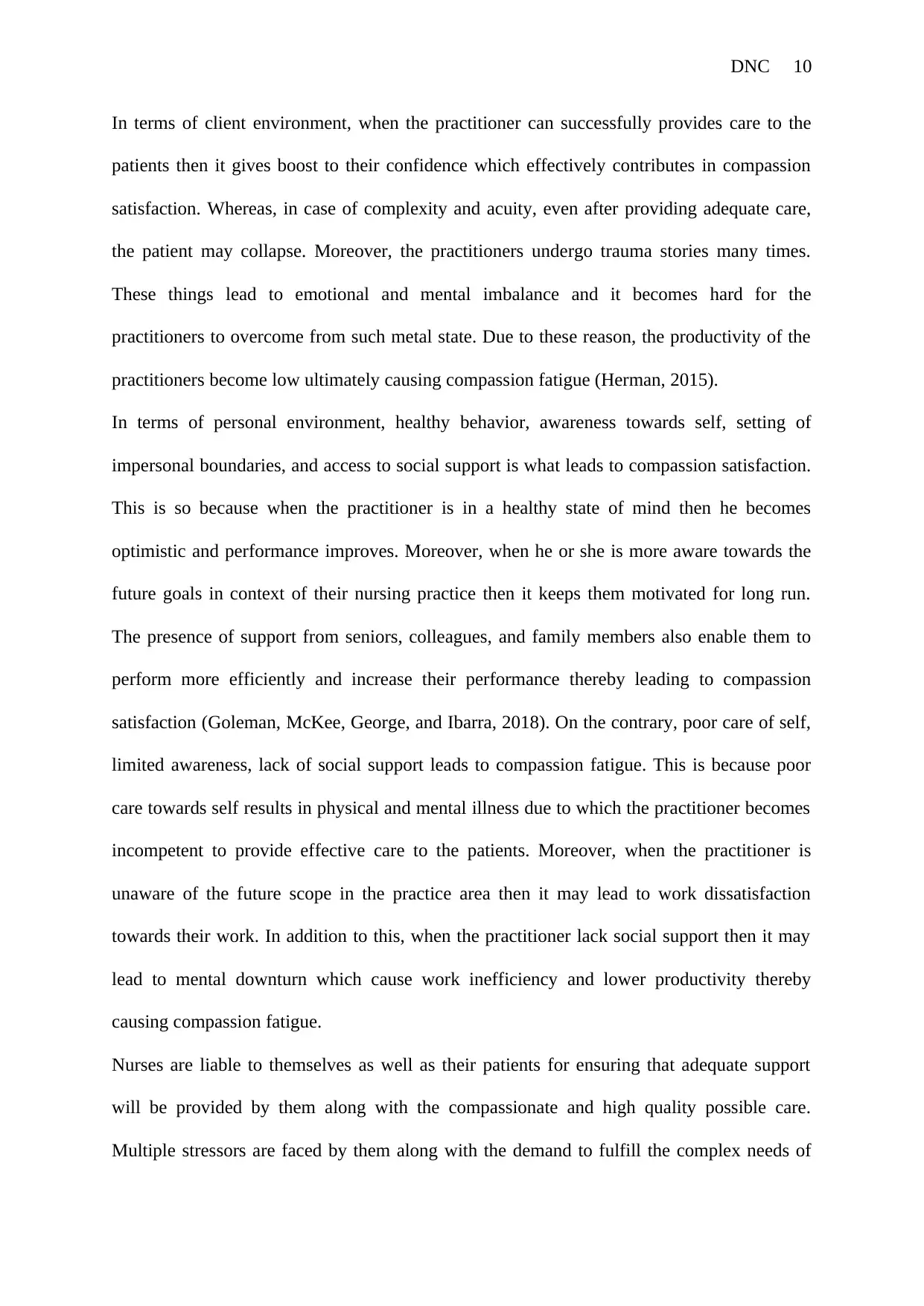
DNC 10
In terms of client environment, when the practitioner can successfully provides care to the
patients then it gives boost to their confidence which effectively contributes in compassion
satisfaction. Whereas, in case of complexity and acuity, even after providing adequate care,
the patient may collapse. Moreover, the practitioners undergo trauma stories many times.
These things lead to emotional and mental imbalance and it becomes hard for the
practitioners to overcome from such metal state. Due to these reason, the productivity of the
practitioners become low ultimately causing compassion fatigue (Herman, 2015).
In terms of personal environment, healthy behavior, awareness towards self, setting of
impersonal boundaries, and access to social support is what leads to compassion satisfaction.
This is so because when the practitioner is in a healthy state of mind then he becomes
optimistic and performance improves. Moreover, when he or she is more aware towards the
future goals in context of their nursing practice then it keeps them motivated for long run.
The presence of support from seniors, colleagues, and family members also enable them to
perform more efficiently and increase their performance thereby leading to compassion
satisfaction (Goleman, McKee, George, and Ibarra, 2018). On the contrary, poor care of self,
limited awareness, lack of social support leads to compassion fatigue. This is because poor
care towards self results in physical and mental illness due to which the practitioner becomes
incompetent to provide effective care to the patients. Moreover, when the practitioner is
unaware of the future scope in the practice area then it may lead to work dissatisfaction
towards their work. In addition to this, when the practitioner lack social support then it may
lead to mental downturn which cause work inefficiency and lower productivity thereby
causing compassion fatigue.
Nurses are liable to themselves as well as their patients for ensuring that adequate support
will be provided by them along with the compassionate and high quality possible care.
Multiple stressors are faced by them along with the demand to fulfill the complex needs of
In terms of client environment, when the practitioner can successfully provides care to the
patients then it gives boost to their confidence which effectively contributes in compassion
satisfaction. Whereas, in case of complexity and acuity, even after providing adequate care,
the patient may collapse. Moreover, the practitioners undergo trauma stories many times.
These things lead to emotional and mental imbalance and it becomes hard for the
practitioners to overcome from such metal state. Due to these reason, the productivity of the
practitioners become low ultimately causing compassion fatigue (Herman, 2015).
In terms of personal environment, healthy behavior, awareness towards self, setting of
impersonal boundaries, and access to social support is what leads to compassion satisfaction.
This is so because when the practitioner is in a healthy state of mind then he becomes
optimistic and performance improves. Moreover, when he or she is more aware towards the
future goals in context of their nursing practice then it keeps them motivated for long run.
The presence of support from seniors, colleagues, and family members also enable them to
perform more efficiently and increase their performance thereby leading to compassion
satisfaction (Goleman, McKee, George, and Ibarra, 2018). On the contrary, poor care of self,
limited awareness, lack of social support leads to compassion fatigue. This is because poor
care towards self results in physical and mental illness due to which the practitioner becomes
incompetent to provide effective care to the patients. Moreover, when the practitioner is
unaware of the future scope in the practice area then it may lead to work dissatisfaction
towards their work. In addition to this, when the practitioner lack social support then it may
lead to mental downturn which cause work inefficiency and lower productivity thereby
causing compassion fatigue.
Nurses are liable to themselves as well as their patients for ensuring that adequate support
will be provided by them along with the compassionate and high quality possible care.
Multiple stressors are faced by them along with the demand to fulfill the complex needs of
Paraphrase This Document
Need a fresh take? Get an instant paraphrase of this document with our AI Paraphraser
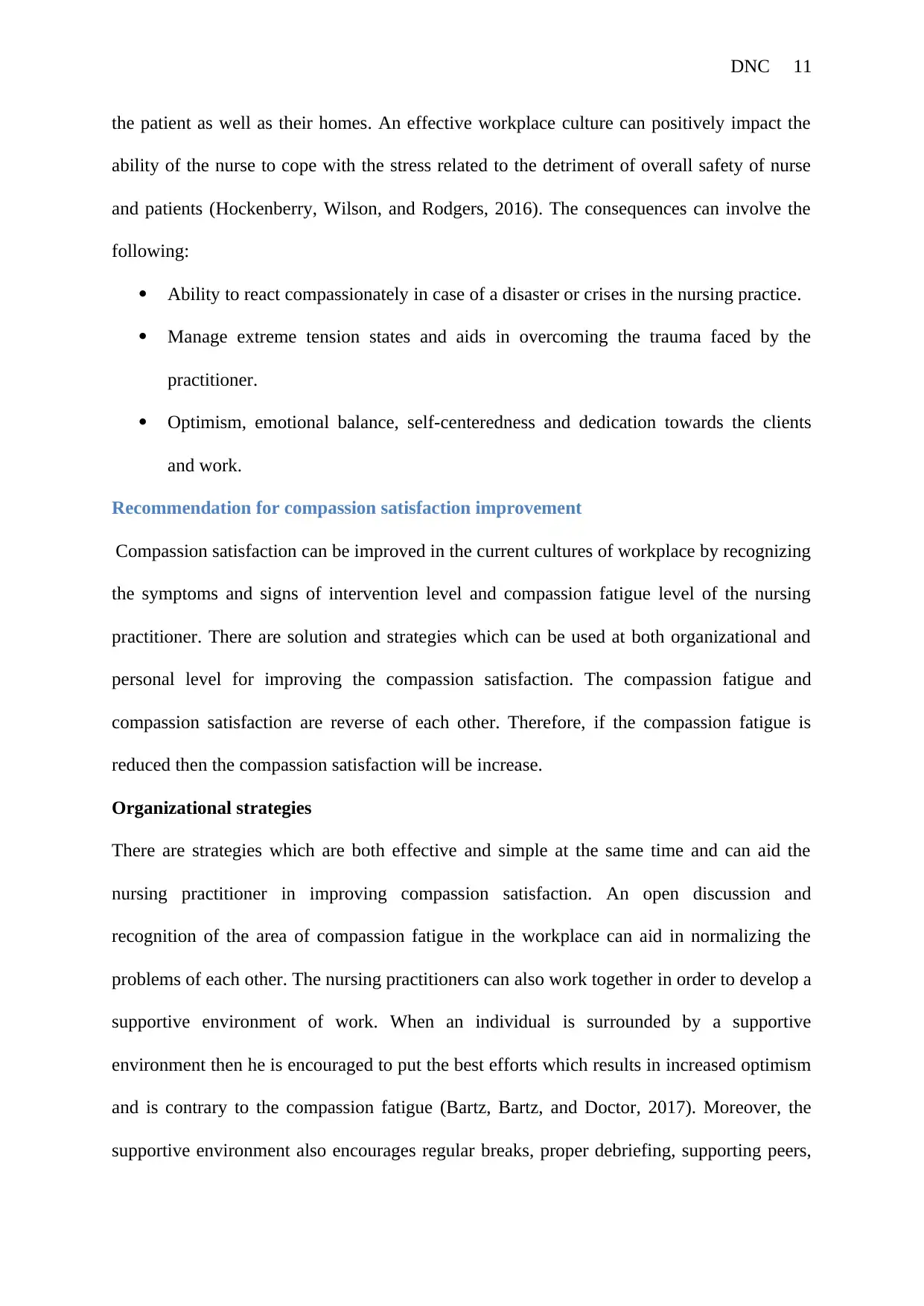
DNC 11
the patient as well as their homes. An effective workplace culture can positively impact the
ability of the nurse to cope with the stress related to the detriment of overall safety of nurse
and patients (Hockenberry, Wilson, and Rodgers, 2016). The consequences can involve the
following:
Ability to react compassionately in case of a disaster or crises in the nursing practice.
Manage extreme tension states and aids in overcoming the trauma faced by the
practitioner.
Optimism, emotional balance, self-centeredness and dedication towards the clients
and work.
Recommendation for compassion satisfaction improvement
Compassion satisfaction can be improved in the current cultures of workplace by recognizing
the symptoms and signs of intervention level and compassion fatigue level of the nursing
practitioner. There are solution and strategies which can be used at both organizational and
personal level for improving the compassion satisfaction. The compassion fatigue and
compassion satisfaction are reverse of each other. Therefore, if the compassion fatigue is
reduced then the compassion satisfaction will be increase.
Organizational strategies
There are strategies which are both effective and simple at the same time and can aid the
nursing practitioner in improving compassion satisfaction. An open discussion and
recognition of the area of compassion fatigue in the workplace can aid in normalizing the
problems of each other. The nursing practitioners can also work together in order to develop a
supportive environment of work. When an individual is surrounded by a supportive
environment then he is encouraged to put the best efforts which results in increased optimism
and is contrary to the compassion fatigue (Bartz, Bartz, and Doctor, 2017). Moreover, the
supportive environment also encourages regular breaks, proper debriefing, supporting peers,
the patient as well as their homes. An effective workplace culture can positively impact the
ability of the nurse to cope with the stress related to the detriment of overall safety of nurse
and patients (Hockenberry, Wilson, and Rodgers, 2016). The consequences can involve the
following:
Ability to react compassionately in case of a disaster or crises in the nursing practice.
Manage extreme tension states and aids in overcoming the trauma faced by the
practitioner.
Optimism, emotional balance, self-centeredness and dedication towards the clients
and work.
Recommendation for compassion satisfaction improvement
Compassion satisfaction can be improved in the current cultures of workplace by recognizing
the symptoms and signs of intervention level and compassion fatigue level of the nursing
practitioner. There are solution and strategies which can be used at both organizational and
personal level for improving the compassion satisfaction. The compassion fatigue and
compassion satisfaction are reverse of each other. Therefore, if the compassion fatigue is
reduced then the compassion satisfaction will be increase.
Organizational strategies
There are strategies which are both effective and simple at the same time and can aid the
nursing practitioner in improving compassion satisfaction. An open discussion and
recognition of the area of compassion fatigue in the workplace can aid in normalizing the
problems of each other. The nursing practitioners can also work together in order to develop a
supportive environment of work. When an individual is surrounded by a supportive
environment then he is encouraged to put the best efforts which results in increased optimism
and is contrary to the compassion fatigue (Bartz, Bartz, and Doctor, 2017). Moreover, the
supportive environment also encourages regular breaks, proper debriefing, supporting peers,
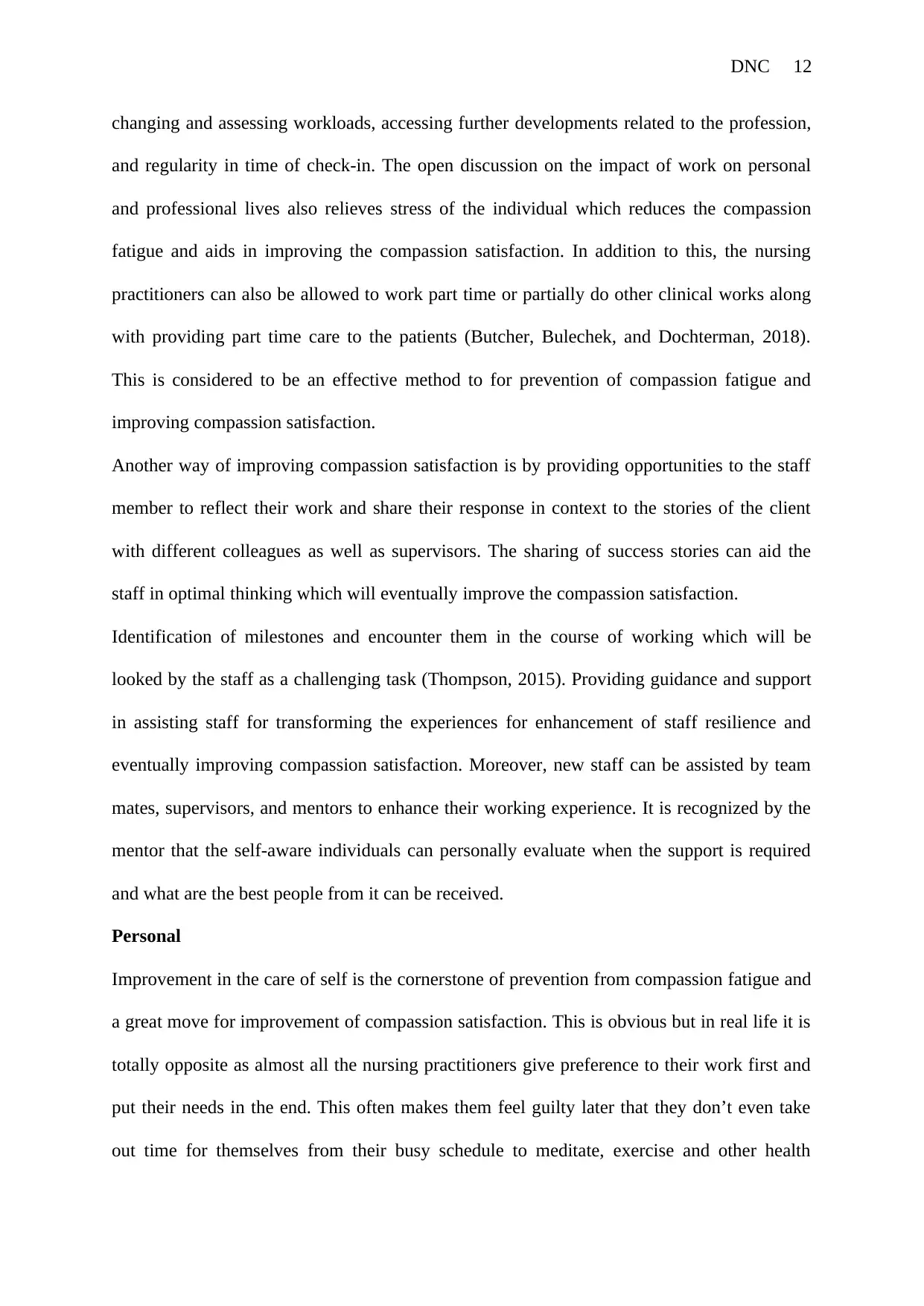
DNC 12
changing and assessing workloads, accessing further developments related to the profession,
and regularity in time of check-in. The open discussion on the impact of work on personal
and professional lives also relieves stress of the individual which reduces the compassion
fatigue and aids in improving the compassion satisfaction. In addition to this, the nursing
practitioners can also be allowed to work part time or partially do other clinical works along
with providing part time care to the patients (Butcher, Bulechek, and Dochterman, 2018).
This is considered to be an effective method to for prevention of compassion fatigue and
improving compassion satisfaction.
Another way of improving compassion satisfaction is by providing opportunities to the staff
member to reflect their work and share their response in context to the stories of the client
with different colleagues as well as supervisors. The sharing of success stories can aid the
staff in optimal thinking which will eventually improve the compassion satisfaction.
Identification of milestones and encounter them in the course of working which will be
looked by the staff as a challenging task (Thompson, 2015). Providing guidance and support
in assisting staff for transforming the experiences for enhancement of staff resilience and
eventually improving compassion satisfaction. Moreover, new staff can be assisted by team
mates, supervisors, and mentors to enhance their working experience. It is recognized by the
mentor that the self-aware individuals can personally evaluate when the support is required
and what are the best people from it can be received.
Personal
Improvement in the care of self is the cornerstone of prevention from compassion fatigue and
a great move for improvement of compassion satisfaction. This is obvious but in real life it is
totally opposite as almost all the nursing practitioners give preference to their work first and
put their needs in the end. This often makes them feel guilty later that they don’t even take
out time for themselves from their busy schedule to meditate, exercise and other health
changing and assessing workloads, accessing further developments related to the profession,
and regularity in time of check-in. The open discussion on the impact of work on personal
and professional lives also relieves stress of the individual which reduces the compassion
fatigue and aids in improving the compassion satisfaction. In addition to this, the nursing
practitioners can also be allowed to work part time or partially do other clinical works along
with providing part time care to the patients (Butcher, Bulechek, and Dochterman, 2018).
This is considered to be an effective method to for prevention of compassion fatigue and
improving compassion satisfaction.
Another way of improving compassion satisfaction is by providing opportunities to the staff
member to reflect their work and share their response in context to the stories of the client
with different colleagues as well as supervisors. The sharing of success stories can aid the
staff in optimal thinking which will eventually improve the compassion satisfaction.
Identification of milestones and encounter them in the course of working which will be
looked by the staff as a challenging task (Thompson, 2015). Providing guidance and support
in assisting staff for transforming the experiences for enhancement of staff resilience and
eventually improving compassion satisfaction. Moreover, new staff can be assisted by team
mates, supervisors, and mentors to enhance their working experience. It is recognized by the
mentor that the self-aware individuals can personally evaluate when the support is required
and what are the best people from it can be received.
Personal
Improvement in the care of self is the cornerstone of prevention from compassion fatigue and
a great move for improvement of compassion satisfaction. This is obvious but in real life it is
totally opposite as almost all the nursing practitioners give preference to their work first and
put their needs in the end. This often makes them feel guilty later that they don’t even take
out time for themselves from their busy schedule to meditate, exercise and other health
⊘ This is a preview!⊘
Do you want full access?
Subscribe today to unlock all pages.

Trusted by 1+ million students worldwide
1 out of 16
Related Documents
Your All-in-One AI-Powered Toolkit for Academic Success.
+13062052269
info@desklib.com
Available 24*7 on WhatsApp / Email
![[object Object]](/_next/static/media/star-bottom.7253800d.svg)
Unlock your academic potential
Copyright © 2020–2025 A2Z Services. All Rights Reserved. Developed and managed by ZUCOL.





